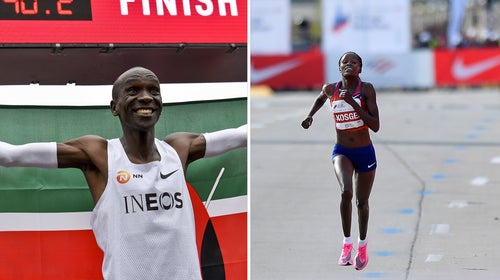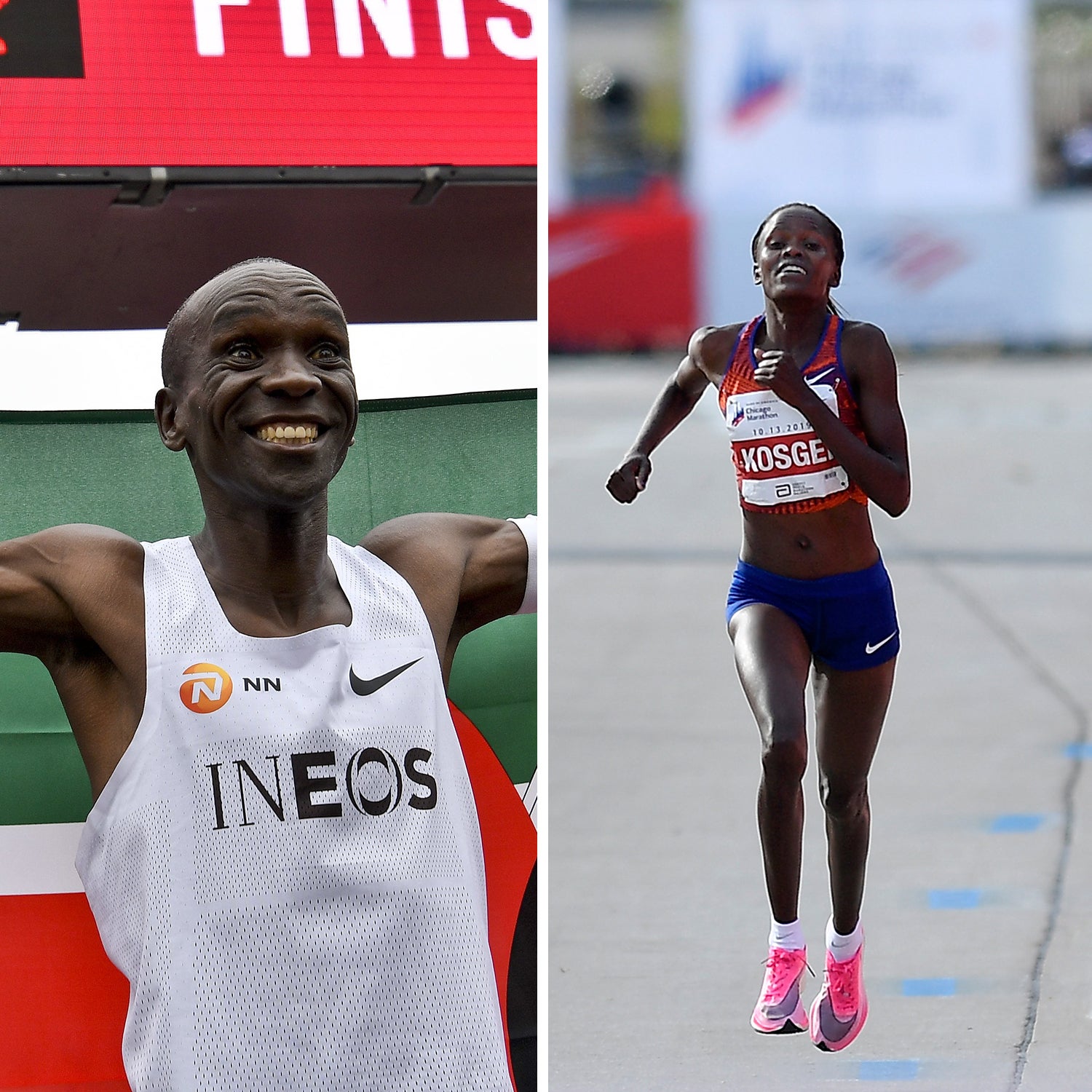The most surprising thing about Eliud Kipchoge’s barrier-smashing, rule-bending performance in Vienna over the weekend was how unsurprising it actually was. He ran 1:59:40.2 for 26.2 miles, a feat that until a few years ago would have sounded like bad science fiction. But the paradigm had already shifted. The surprise, instead, came the next day in Chicago, when a less heralded Kenyan, Brigid Kosgei, slashed more than a minute off Paula Radcliffe’s 16-year-old marathon world record—a mark than the two-hour barrier for men.
On an intellectual level, I already understood how far the goal posts have moved. Two years ago, when Kipchoge was preparing for , fans and experts were nearly unanimous in dismissing his chances of even getting close to two hours. This time, all the straw polls and online surveys I saw found that about two thirds of respondents thought he’d succeed. Kipchoge’s time of 2:00:25 at Breaking2 showed that he was close, and further refinements in logistics, fueling, drafting, and shoes made the barrier seem eminently possible.
But on a deeper, more intuitive level, I still clung to the notion that the marathon distance had some tricks up its sleeve—that just because something was theoretically possible didn’t mean it was probable or even likely. I woke up in the wee hours of Saturday morning expecting either to see Kipchoge struggle, or, if he didn’t, to relive some of the awe I felt when I watched his Breaking2 performance and his subsequent world record in Berlin last year. Instead, it felt more like watching Simone Biles corkscrewing through the air above the balance beam: you know something could go wrong at any moment, but you also know that it probably won’t. That’s a testament to Kipchoge’s totally unprecedented consistency. But there’s more to it than that.
For those interested in running science, the big question after Breaking2 was how much each of the various refinements and innovations contributed to Kipchoge’s performance. The two biggest factors, I figured, were the drafting benefits of a swarm of tightly packed pacemakers and the efficiency boost of Nike’s Vaporfly shoe, which featured a curved carbon fiber plate and a thick layer of ultralight and resilient foam. Other factors like in-race bottles passed from a bicycle and a lack of sharp corners might have contributed a handful of seconds, but weren’t a big factor. In theory, either drafting or the shoes could have provided several minutes’ advantage; in practice, it wasn’t clear which was more important.
When Kipchoge ran 2:01:39 in Berlin, he ran alone for most of the second half of the race, suggesting that drafting wasn’t as important as initially thought. Indeed, during the INEOS race in Vienna, Kipchoge kept inexplicably drifting off to the side, out of the slipstream of the pacemaker in front of him, without any obvious ill effects. That leaves one obvious candidate. Indeed, as LetsRun’s Jonathan Gault a few weeks ago, the five fastest record-eligible marathons in history have all been run in the last 13 months—and they’ve all been run in versions of Nike’s Vaporfly.
There was one lingering disconnect in this picture, though. If the Vaporfly was so great, why hadn’t the women’s record fallen? Radcliffe’s record of 2:15:25 had stood since 2003, long before the Vaporfly emerged. The only woman to give it even a hint of a scare, Mary Keitany, was wearing Adidas shoes. So when Kosgei ran 2:14:04 in Chicago, while it was certainly a surprise, it also made perfect sense. There’s no longer any room for doubt about the massive effects of shoes with carbon fiber plates.
It’s worth noting that “the shoes” aren’t a stationary target. Breaking2 featured a bespoke version of the original Vaporfly 4%, named for its lab-tested 4 percent (on average) boost in running economy compared to the fastest racing flat offered by either Nike or Adidas. The current model, the Vaporfly Next%, reportedly gives a roughly 5 percent boost, which in theory should shave a couple of minutes from a world-class marathon. Kipchoge was wearing a shoe that Nike has only as “a future edition of Nike’s NEXT% marathon shoe,” but which look substantially different, with a thicker stack and bizarre pods under the forefoot. According to the rumor mill, they will be called the Alphafly, and suggests there are a bunch of new features in there, possibly including multiple carbon fiber plates.
I don’t want to make too many guesses about what’s really in the shoes until we know for sure. But frankly, we shouldn’t have to guess. Last year, the IAAF, track and field’s international governing body, introduced in response to the Vaporfly controversy: “Any type of shoe used must be reasonably available to all in the spirit of the universality of athletics. Shoes must not be constructed so as to give athletes any unfair assistance or advantage.” The second part of that rule remains as vague and unhelpful as before, since “unfair” is undefined and therefore essentially meaningless. But the first part of the rule is crystal clear.
Kosgei’s postrace interviews made it sound like she was wearing the same shoe as Kipchoge: “I was just 50-50 to use the pink one,” LetsRun quoted her as saying. “But something come in my mind, say that yesterday, Kipchoge run and use the same shoes and the other pacemakers [did too]. Why not me?” In photos of the race, Kosgei’s shoes actually look more like the commercially available Vaporfly Next%. Let’s hope that’s the case, otherwise even the relatively toothless existing rules are being ignored.
Regardless of what Kosgei was wearing this time, it seems highly probable that she’ll be wearing the newest model in next year’s Olympics. And I’ll confess that the unending complexification of the shoes is starting to wear me down.
Ever the since , I’ve been torn about their place in the sport. Instinctively, I thought they should be banned, in keeping with the simplicity of person-against-person competition in running. But I struggled to rationalize why this particular improvement in running shoes was any different from all the previous improvements in shoes and other equipment that separate us from the three-hour marathoners who contested the first modern Olympics.
By far my favorite part of the Vienna broadcast on Saturday morning was the post-race interviews. Kipchoge is an amazingly charismatic guy. He’s impossible not to like, and despite all the asterisks, his performance there will be remembered for decades. He has put the marathon on front pages around the world in a way that it hasn’t been for generations. He’s the only person in the world whose races I’ll get up at 2:00 A.M. to watch, and I’ll keep doing that for as long as he keeps amazing us. But now that he’s finally checked sub-two off the list, I hope his shoes stop getting faster. And better yet, I hope the IAAF lays down some clear and unambiguous technical rules to make sure they don’t.
My book, , with a foreword by Malcolm Gladwell, is now available. For more, join me on and , and sign up for the Sweat Science .


